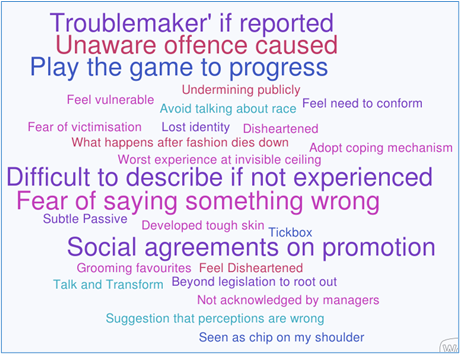
| Date | Author |
|---|---|
| 6th February 2022 | Fola Ikpehai |
The 7th of February kicks off UK Race Equality Week, an annual UK-wide movement uniting thousands of organisations and individuals to address the barriers to race equality in the workplace.
In this post, Principal Consultant Fola Ikpehai shares a reflective perspective on race and ethnicity in higher education, drawing on her own experiences and her work with universities across the UK.
It took me a while to get going on this blog. I had a lot going through my mind because I have to acknowledge, upfront, a certain conflict between what I wanted to say personally about race and ethnicity in higher education and what I needed to say professionally. So, I have decided to do both!
Before I start, I should probably put my personal thoughts, which you may or may not agree with, in context – “I am a black woman”, just in case you haven’t seen my SUMS Profile!
Thinking about race and ethnic heritage, there are two things that continue to grate on my nerves and really annoy me:
- First, issues of race – racism, and inequalities linked to race and ethnicity – are still here with us in 2022. Historic events linked to racist theories, policies and behaviour are clearly inexcusable and these issues should never have seen the light of day. However, this is the 21st century and we have seemingly moved only baby steps forward.
- Second, the language used in describing racial and ethnic equity and equality. In my view, this is part of the problem.
I have seen extensive debate online about my second point. So, I will pin my colours to the mast and state that beyond this paragraph, I will not be using the terms BAME (Black, Asian and minority ethnic) or POC (Person of Colour). I find them unsatisfactory. The term BAME, in my view, attempts to do too much. It mixes skin colour, with ethnicity, with the population size of people of various ethnicities – and does none of these justice. While the term Person of Colour/POC just makes me laugh. The next time you notice a ‘see-through’ person (aka – non-person of colour) walking by please let me know! My point is, skin colour is not a binary concept, and there is no such thing as a ‘non-colour’ when it comes to skin tone. So, why do we all use this term?
I recognise the need for some form of categorisation for statistical purposes. However, there is no reason why policy papers on racial and ethnic diversity, or discussions at meetings should not seek to identify people of all races and ethnicities as equally important, instead of seeking to cover up certain in-equalities through the use of the collective B and P-acronyms. I was actually gratified to watch the recording of the Launch Event for Race Equality Week 2022 recently and not hear the B-acronym or the P-acronym/term mentioned even once. Well done!
I know I am not alone with this thought. The quote below is from a recent SUMS review of a university’s race and ethnicity strategy. One survey respondent states:
“The use of the term BAME needs to be looked at. Many policies use the term BAME (e.g. ‘when the BLM movement was at its highest, BAME was addressed’); ethnic and racial minority groups need to be referred to separately as we all don’t face the same issues. It feels like we have been ‘bunged up together’ as one non-white race and that in itself dismisses a lot of issues.”
Some may say language doesn’t matter, it’s attitudes and behaviour that count. I respectfully disagree – I think both are important!
I was going to present alternatives to these terms in this article but having tested my proposals with my two sons – one who agreed with my suggestions and one who didn’t, I have decided not to initiate that conversation just yet. However, I do feel that the HE sector, with our collective minds, is well placed to debate and come up with simple alternatives to these two (in my view) unsatisfactory terms.
Race and Ethnicity in Higher Education
In spite of everything, there are still issues of racism, inequity and inequality. Whether or not these fit the definition of institutional racism, they cannot be ignored.
In the briefing paper, Change Starts Now: Making HEIs Racially Inclusive, my colleagues Helen Baird and Jeannette Strachan have shared extensive insight into approaches to supporting staff and students; leadership of equality, diversity and inclusion; creating an anti-racist university; and sector-wide race initiatives. I do not want to repeat the, still relevant, material covered in that report. Instead, I have chosen to come at the conversation around race and ethnicity from a slightly different change management perspective.
There are several well-established criteria that underpin successful, sustained change. In the sections that follow, I will apply these criteria to intelligence gathered from race and ethnicity reviews conducted by SUMS, seeking to explore where the gaps are in the sector.
I invite you to get your red, green and amber markers out. Give your institution a quick assessment of where you feel you are against each of these criteria when you consider your university’s current approach to addressing issues of race and ethnicity.
The Six Criteria for Successful and Sustainable Change Are:
- A firm and clear commitment from leadership to make the change
- A simple and consistent description of success and clearly articulated benefits
- Change that is focused on outcomes, not deliverables
- Adopting the right approach to solving the right problem(s)
- An appropriate level of stakeholder support and engagement at all levels in the organisation
- Competencies (knowledge, skills and attitudes) are built around sustaining the change.
A Firm and Clear Commitment from Leadership to Make the Change
In the wake of the horrific events of 2020, there has been an increased emphasis and commitment to addressing issues of race inequality across all sectors – and universities are no different. As evidence of the increased profile, members of our SUMS Change Community of Practice noted the difficulty that Higher Educational Institutions are now facing to recruit senior officers in EDI roles.
We have seen new strategies developed, policies drafted, and websites updated. It is also heartening to reflect on sentiments echoed across many of our reviews about the strength of leadership commitment.
“There is good leadership at the top – senior management have taken positive steps to keep this issue high on the agenda.”
In spite of some concerns expressed that the current focus might be short-lived, I rate leadership commitment as a growing area of strength for the sector.
A Simple and Consistent Description of Success and Clearly Articulated Benefits
Let’s forget for a moment that to be treated fairly and equitably is every employee’s right, irrespective of their race or ethnic heritage. Whatever happened to a focus on valuing diversity? Valuing diversity in all its facets is more than compliance. It is a firm acknowledgement that building a diverse workforce – with that diversity shown at all levels up to the Board room – has numerous benefits – from the quality of our service delivery, to the tone of our marketing and communication messages, to the content of our strategies.
A participant in one of our recent Race and Ethnicity Reviews commented:
“Why is the focus always about nurturing, when do we get to the point where [racial diversity networks] are recognised as influential bodies that can add value to the organisation by influencing strategy?”
My rating is that this is an area of relative weakness for the sector. Benefits are more than the numbers and percentages – it’s about recognising the value added and using the skills across a diverse workforce to deliver improvements.
Change Focused on Outcomes, Not Deliverables
Now, this is a really critical area. Often in our reviews, we hear “There is a lot of activity, things are happening but there is no change to lived experiences”. This is often because the focus is on inputs – the number of events delivered; the number of kite marks achieved, etc., without considering the actual outcomes needed. We have forgotten the golden thread – making a clear link between inputs, outputs and outcomes that we want to see. We need to bridge that gap and ensure that our focus is on the long-term and not the volume of activities.
Somewhat tenuously linked to this message is the word cloud below which depicts keywords and phrases used across survey and focus group discussions during a recent review. The words signified how people felt, and the cloud demonstrates the need to look beyond activity, towards changing mindsets, perceptions and lived experiences.
Generally, this is an area where the HE sector needs to improve by recognising success through outcomes, as opposed to stopping at inputs.
Adopting the Right Approach to Solving the Right Problem(s)!
I have two examples below which I think highlight strengths in the sector around adopting the right approach to the right problem.
I have permission from the author, to refer to work carried out in the Biology Department at the University of St Andrew, which was focused on decolonising the curriculum. Professor Kevin Laland identified a gap and published an excellent lecture aimed at decolonising the Biology Curriculum. In his lecture, he spoke about a number of inaccuracies and prejudices built into past scientific theories and practice. He also highlighted a number of Black scientists and individuals, largely unrecognised, who contributed to areas of biology such as cancer research, protein synthesis (linked to DNA research), cell biology and animal behaviour. I have to confess that some of the historical theories mentioned in the lecture made me cringe, especially when I consider that some of these inaccuracies have made their way into present-day stereotypes and prejudices. I felt it was a brave move by the Department of Biology and Professor Laland, demonstrating an acknowledgement of the mistakes of the past (and yes, I do recognise that the lecture includes those terms that I criticised in my personal segment at the start, but that does not detract from the robust messages conveyed!).
We have also seen examples of initiatives that address issues relating to clinical practice and race. In one of our reviews, we learnt that:
“The championing of the need for teaching about clinical signs on darker skin tones via a student-staff partnership project grant has had impact, resulting in the publication of a handbook being used in the university and beyond.”
These are just two examples, but I do think, generally, this is an area of some strength in many institutions where individuals or groups have identified a need and taken the initiative to come up with a solution.
An Appropriate Level of Stakeholder Support and Engagement
One might feel that qualities like fairness, equity and equality do not require extensive stakeholder engagement – communication definitely, but engagement? After all, everyone knows that these are the right qualities to apply irrespective of where one sits on the racial spectrum, or whatever one’s ethnic heritage.
It is a cold, hard truth that change is easiest when everyone sees something in it for themselves. We have found in our work a range of views that show what happens when leaders fail to take everyone along on issues of race and ethnicity. This area is also hardest to achieve because, as any change professional will tell you, you never get fundamental change without a shift in personal values, beliefs, attitudes and behaviour. This would be, in my estimation, the area where the sector needs to improve the most. Awareness of the issues and causes of inequity and equality must evolve into acceptance that it is everyone’s responsibility to address this. Acceptance needs to give way to a real commitment to action (from all stakeholders, not just leadership), to achieve outcomes that reduce inequity and inequality.
Getting this element right will avoid thoughts such as those shared below:
“Following some of the awareness-raising, several managers have spoken of race/equality changes as a tick box exercise (“you know, we have to do this”) rather than with any respect/acknowledgement of need.”
“Awareness is growing among those who are keen to understand, but this isn’t reaching everyone, not everyone is keen to engage in the conversations, and I’m not sure to what extent mindsets are changing.”
We have also found that, far from full engagement, some initiatives around race and ethnicity have been perceived to cause tension:
“Rather than focus on race and ethnicity, why not treat all people equally? This helps no-one. It risks creating racial tensions which didn’t necessarily exist in the first place.’
‘These actions risk causing division rather than unity, especially in the current political climate.”
Real stakeholder engagement – across the racial spectrum, at all management and non-management levels, and throughout the university – is critical for change to happen. This is an area where the sector is making progress – engaging all staff in surveys and discussions around race and ethnic diversity (for example). However, there is room for improvement.
Build Competencies (Knowledge, Skills, Attitudes) to Sustain the Change
Stakeholder engagement and competency development go hand in hand. We have seen a lot of activity in universities focused on awareness-raising with university staff highlighting the following specific needs:
- Line manager training on performance management, focusing on achievements and removing racial bias
- Fairer recruitment training for all managers and recruiters.
The general message is that there is a recognition of the need to build competencies around race and ethnicity. A potential gap is the limited focus on encouraging open and honest debates to drive competencies beyond awareness towards a fundamental change in attitude and values. It is the latter that will eventually drive a cultural shift.
In summary, across the six criteria for successful change, the sector is heading in the right direction but there is a way to go and challenges to face.
Reorienting Activity Around Race and Ethnicity in Higher Education: Less Talk, More Action
In their conclusion to the briefing paper looking at race and ethnicity in higher education, Change Starts Now: Making HEIs Racially Inclusive, my colleagues wrote, “Many universities have now expressed commitments about the need to achieve racial inclusion. It is now time to deliver on those commitments.”
Perhaps in the future, when these commitments are delivered, and we have achieved the required cultural shift, we will get to the point where, irrespective of race or ethnic heritage, we can:
- Tell positive, rather than negative, stories based on our experiences
- Make issues of under-representation at senior levels in our institutions a thing of the past
- Eliminate achievement gaps for our students
- Ensure that the word privilege does not automatically come with the prefix ‘white’.
The ship is turning slowly, but it is turning.
Please share your views and contact us at sums@reading.ac.uk if you require support in this area.









